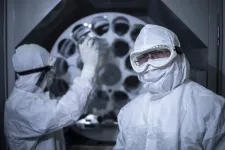(Press-News.org) In research that may be a step forward toward finding personalized treatments for Tourette disorder, scientists at Rutgers University–New Brunswick have bred mice that exhibit some of the same behaviors and brain abnormalities seen in humans with the disorder.
As reported in the Proceedings of the National Academy of Sciences, the researchers, using a technique known as CRISPR/Cas9 DNA editing that selectively modifies the DNA of living organisms, inserted the same genetic mutations found in humans with Tourette disorder into the corresponding genes in mouse embryos. After the mice were born, the scientists observed their behavior compared with littermates without the gene mutation insertion. The mutations that were inserted were discovered by some members of the same research team who have spent more than a decade focused on investigating genetic factors in Tourette disorder.
The researchers said the findings indicate that these mice are a highly useful “model” to study the neurobiology of Tourette disorder and to test new medications.
“There are no medicines specifically developed for Tourette disorder and repurposing other drugs has worked poorly, with too many side effects,” said co-senior author Jay Tischfield, the Duncan and Nancy MacMillan Distinguished Professor of Genetics in the Department of Genetics in the Rutgers School of Arts and Sciences and a pioneer in the study of Tourette disorder. “Until now, the problem has been a lack of an animal model by which to test new or existing medications.”
Tourette disorder is a disorder of the nervous system that affects children, adolescents and adults. The condition is characterized by sudden, involuntary movements or sounds called tics. Tics can be mild, moderate or severe, and are disabling in some cases.
Tourette disorder doesn't affect lifespan, but it often adversely impacts the experience of people with the disorder and the people with whom they interact. The Centers for Disease Control and Prevention has estimated that one of every 162 children have the disorder, though the number may be higher.
Using cameras that recorded the mice’s actions and employing a form of artificial intelligence known as machine learning, the researchers found the genetically engineered mice exhibited two key characteristics seen in humans with Tourette disorder: They engaged in repetitive motor behaviors or tics, and they exhibited what neuroscientists call “sensorimotor gating deficits,” a neural process whereby the brain filters out redundant or irrelevant stimuli.
Cara Nasello, a research associate in the Departments of Genetics and Cell Biology and Neuroscience and the first author of the study, said gating deficits in people with Tourette syndrome can be viewed as a difficulty in processing sensory information. A person without the disorder who listens to a series of sounds such as a beeping car horn wouldn’t be startled after the first honk because that person’s brain can link the second and subsequent sounds to the first one. A person with Tourette disorder might be startled by each separate sound, especially if it increases in volume.
The genetically engineered mice reacted the same way humans with the disorder would react to individual sounds that were part of a pattern – they showed a startle response to each tone, Nasello said.
In collaboration with Miriam Bocarsly from the Department of Pharmacology, Physiology and Neuroscience at Rutgers New Jersey Medical School, the team found evidence that the gene mutations altered the levels of a brain chemical known as dopamine. As with humans with Tourette disorder who are treated with a drug that alters the levels of dopamine, the processing deficits and repetitive behaviors seen in the mice decreased in intensity when they were administered the same drug.
“An easy way to think about this is that we have inserted a gene mutation and it’s changed the neural circuitry of the mice’s brains,” said Max Tischfield, an assistant professor in the Department of Cell Biology and Neuroscience in the Rutgers School of Arts and Sciences, and the senior corresponding author of the study. “And those changes are altering how a brain chemical like dopamine, which in humans is important for cognition and motor behavior, allows the mice brain cells to communicate.”
The researchers credited much of the success of their work to the contributions of families with Tourette disorder who over the past 15 years donated genetic samples to the research group.
“These families did this out of the goodness of their hearts with the idea of moving the field forward,” said Gary Heiman, a co-senior author of the study and a professor in the Department of Genetics who recruited families of members with Tourette disorder throughout the world and organized blood collection and genetic repositories. “They want to have a better understanding of this mysterious disorder and for us to come up with better treatments, not only for the people who are currently suffering with the disorder but also for future generations.”
The scientists said the techniques they employed in their research are applicable to researchers studying other complex disorders caused by multiple genes, including autism and schizophrenia.
They also hope this advance will attract more researchers to study Tourette disorder.
“So why would a researcher jump into something if there’s little known and they’re left wondering, ‘How do I even start? What do I have at my disposal that would allow me to even scratch the surface of this very complex disorder?’” Max Tischfield said. “And with these mice, not only can we scratch the surface, but we can dig underneath.”
Other Rutgers scientists involved with the study include Lauren Poppi, Joshua Thackray, Riley Wang, Rodna Spaseka, C.K. Johnson and Derek Gordon, all from the Department of Genetics; Junbing Wu, Tess Kowalski, and Angelina Persaud, from the Department of Cell Biology and Neuroscience; and Miriam Mahboob from the Department of Pharmacology, Physiology and Neuroscience at Rutgers New Jersey Medical School.
Researchers from Harvard Medical School and Hamad Bin Khalifa University in Qatar also contributed to the study.
END
Using advanced genetic techniques, scientists create mice with traits of Tourette disorder
Gene-altered rodents could aid the development of new treatments for a brain disorder
2024-05-06
ELSE PRESS RELEASES FROM THIS DATE:
3D video conferencing tool lets remote user control the view
2024-05-06
ITHACA, N.Y. -- Collaborating on a physical object when two people aren’t in the same room can be extremely challenging, but a new remote conferencing system allows the remote user to manipulate a view of the scene in 3D, to assist in complex tasks like debugging complicated hardware.
The system, called SharedNeRF, combines two graphics rendering techniques – one that is slow and photorealistic, and another that is instantaneous but less precise – to help the remote user experience ...
The Ottawa Hospital is expanding life-saving biotherapeutics research and manufacturing to its new campus thanks to $59 million grant
2024-05-06
The Ottawa Hospital is receiving $59 million to boost Canada’s capacity to develop and manufacture life-saving biotherapeutics, including vaccines, gene therapies and cell therapies. Most of the funding ($47 million) will support the construction and operation of a world-class biomanufacturing facility at The Ottawa Hospital’s new campus, while the remainder will enable harmonization and cooperation across six Canadian biomanufacturing facilities.
The funding is part of a $115 million investment from the Government of Canada in the Canadian Pandemic ...
Early neurodevelopmental assessments for predicting long-term outcomes in infants at high risk of cerebral palsy
2024-05-06
About The Study: The results of this study support the potential to identify cerebral palsy and its severity as early as corrected age 3 to 4 months through early neurodevelopmental assessments, but the role of these tests is limited in identifying cognitive and neurodevelopmental impairments.
Authors: Abdul Razak, M.D., of Monash University in Melbourne, Australia, is the corresponding author.
To access the embargoed study: Visit our For The Media website at this link https://media.jamanetwork.com/
(doi:10.1001/jamanetworkopen.2024.9053)
Editor’s ...
Snowfall and drought: $4.8 million field campaign will improve forecasts in western US, led by U-M
2024-05-06
Images
A new science expedition in Yampa Valley, Colorado, will improve forecasts of snowfall and estimates of how climate change will impact snowpack and water availability in the western U.S. mountains, funded with $4.8M from the National Science Foundation.
The field campaign, led by the University of Michigan, brings together scientists from the University of Washington, University of Wisconsin, University of Utah, Colorado State University and Stony Brook University. The team will use an extensive suite of radars and snow-sampling instruments to measure the size and shape of snowflakes and aerosols. ...
SwRI Workbench for Offline Robotics Development™ (SWORD™) launched at Automate 2024
2024-05-06
SAN ANTONIO — May 6, 2024 – Southwest Research Institute is simplifying robotics programming with a new toolkit that embeds computer-aided design (CAD) into robotics motion planning, modeling and execution. The SwRI Workbench for Offline Robotics Development™ (SWORD™) features a user-friendly graphical interface to demystify the fundamental coding required in robot operating system (ROS) application development.
Informed by the Institute’s role in supporting the ROS-Industrial community, SwRI developed ...
Science doesn't understand how ice forms (video)
2024-05-06
WASHINGTON, May 6, 2024 — This video contains incredible macro footage of supercooled water droplets nucleating ice. All George wanted to do was make a crystal-clear ice cube. Instead, he ended up rediscovering dendritic crystal growth, a beautiful phenomenon first described in the 17th century. You’ll never look at your freezer the same way again. https://youtu.be/24TB1vPuzIU?feature=shared
Reactions is a video series produced by the American Chemical Society and PBS Digital Studios. Subscribe to Reactions at http://bit.ly/ACSReactions and ...
Study reveals APOE4 gene duplication as a new genetic form of Alzheimer's disease
2024-05-06
Researchers from the Research Area on Neurological Diseases, Neuroscience, and Mental Health at the Sant Pau Research Institute, led by Dr. Juan Fortea, Director of the Memory Unit of the Neurology Service at the same hospital, have found that over 95% of individuals over 65 years old who have two copies of the APOE4 gene -APOE4 homozygotes- show biological characteristics of Alzheimer's pathology in the brain or biomarkers of this disease in cerebrospinal fluid and PET scans.
The study, published today in Nature Medicine, also concludes that those individuals homozygous for APOE4 also develop ...
Study highlights key predictors of adolescent substance use; special issue of the American Journal of Psychiatry focuses on substance use disorders
2024-05-06
NEW YORK, May 6, 2024 – New research, published online today in the American Journal of Psychiatry, examined a broad range of potential predictors of substance use among adolescents and found sociodemographic variables were the most robust predictors of substance use initiation.
The study is part of a special issue of the journal highlighting advances in understanding the neurobiology and sociodemographic underpinnings of substance use disorders and how this understanding has advanced recognition and treatment. Several authors discussed this work today at a special briefing during the 2024 Annual Meeting of the American Psychiatric ...
Racial and ethnic disparities in initiation of direct oral anticoagulants among Medicare beneficiaries
2024-05-06
About The Study: In this cohort study of Medicare patients with atrial fibrillation, Black and Hispanic patients were less likely to initiate direct oral anticoagulants for atrial fibrillation, although these differences diminished over time. Identifying the factors behind these early disparities is crucial for ensuring equitable access to novel therapies as they emerge for Black and Hispanic populations.
Corresponding Authors: To contact the corresponding authors, email Kamika R. Reynolds, M.S., Ph.D. (kreynolds@ifh.rutgers.edu) and Chintan ...
Behavioral interventions to improve breast cancer screening outreach
2024-05-06
About The Study: These findings show that text messaging women after initial breast cancer screening outreach via either electronic portal or mailings, as well as bulk ordering with or without text messaging, can increase mammogram completion rates.
Corresponding Author: To contact the corresponding author Shivan J. Mehta, M.D., M.B.A., M.S.H.P., email shivan.mehta@pennmedicine.upenn.edu.
To access the embargoed study: Visit our For The Media website at this link https://media.jamanetwork.com/
(doi:10.1001/jamainternmed.2024.0507)
Editor’s Note: Please see the article for additional information, including other authors, author contributions ...
LAST 30 PRESS RELEASES:
Sleeping in on weekends may help boost teens’ mental health
Study: Teens use cellphones for an hour a day at school
After more than two years of war, Palestinian children are hungry, denied education and “like the living dead”
The untold story of life with Prader-Willi syndrome - according to the siblings who live it
How the parasite that ‘gave up sex’ found more hosts – and why its victory won’t last
When is it time to jump? The boiling frog problem of AI use in physics education
Twitter data reveals partisan divide in understanding why pollen season's getting worse
AI is quick but risky for updating old software
Revolutionizing biosecurity: new multi-omics framework to transform invasive species management
From ancient herb to modern medicine: new review unveils the multi-targeted healing potential of Borago officinalis
Building a global scientific community: Biological Diversity Journal announces dual recruitment of Editorial Board and Youth Editorial Board members
Microbes that break down antibiotics help protect ecosystems under drug pollution
Smart biochar that remembers pollutants offers a new way to clean water and recycle biomass
Rice genes matter more than domestication in shaping plant microbiomes
Ticking time bomb: Some farmers report as many as 70 tick encounters over a 6-month period
Turning garden and crop waste into plastics
Scientists discover ‘platypus galaxies’ in the early universe
Seeing thyroid cancer in a new light: when AI meets label-free imaging in the operating room
Neutrophil-to-lymphocyte ratio may aid risk stratification in depressive disorder
2026 Seismological Society of America Annual Meeting
AI-powered ECG analysis offers promising path for early detection of chronic obstructive pulmonary disease, says Mount Sinai researchers
GIMM uncovers flaws in lab-grown heart cells and paves the way for improved treatments
Cracking the evolutionary code of sleep
Medications could help the aging brain cope with surgery, memory impairment
Back pain linked to worse sleep years later in men over 65, according to study
CDC urges ‘shared decision-making’ on some childhood vaccines; many unclear about what that means
New research finds that an ‘equal treatment’ approach to economic opportunity advertising can backfire
Researchers create shape-shifting, self-navigating microparticles
Science army mobilizes to map US soil microbiome
Researchers develop new tools to turn grain crops into biosensors
[Press-News.org] Using advanced genetic techniques, scientists create mice with traits of Tourette disorderGene-altered rodents could aid the development of new treatments for a brain disorder



